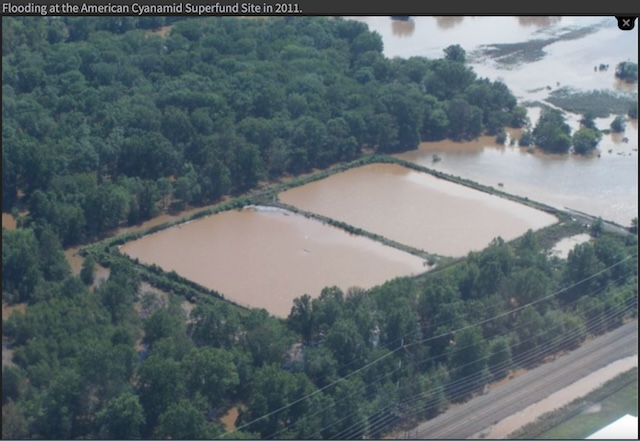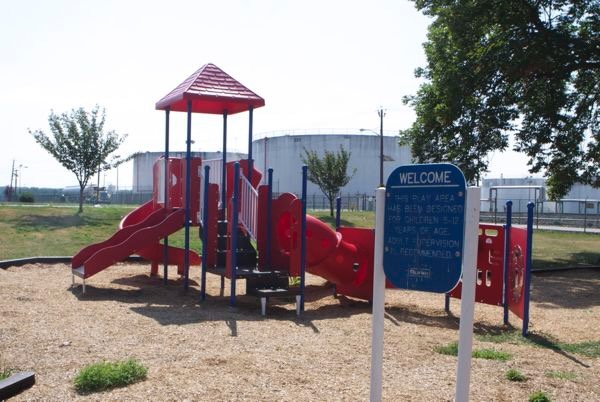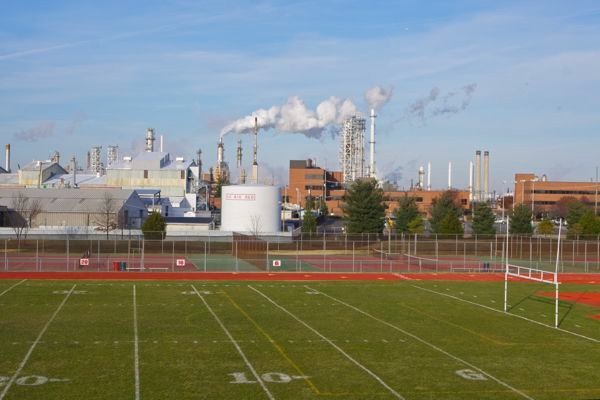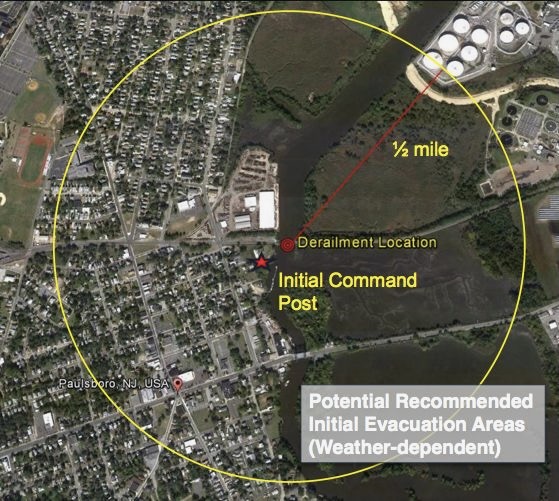DEP Notes “Catastrophic Risks” Of Climate Change At Oil And Chemical Plant Accidents
Proposal Ignores Environmental Justice Issues At 250 Oil And Chemical Plants
DEP Eliminating Significant Regulatory Protections For “Nominal Concentrations” Of Hazardous Chemicals
The Department is using the high-end sea-level rise because the damage or loss due to a discharge, as a result of failed planning for these types of facilities, may have a catastrophic impact or debilitating effect on human health and the environment. ~~~ DEP proposal, page 18)
The Murphy DEP today proposed to update current regulations on the safe storage and prevention of discharge of petroleum and hazardous chemical substances. The rules include emergency response planning and cleanup (read the proposal here).
These regulations are known as the “Discharge Prevention, Containment, And Counter-Measures (DPCC) program rules:
The rules at Discharges of Petroleum and Other Hazardous Substances, N.J.A.C. 7:1E
(the DPHS rules), implement the Spill Compensation and Control Act, N.J.S.A. 58:10-23.11a et seq. (the Spill Act or the Act), which sets stringent standards for discharge prevention and emergency response requirements for facilities storing or handling hazardous substances. The DPHS rules establish standards for emergency response in the event of a discharge of a hazardous substance. The DPHS rules also establish standards for discharge prevention for
major facilities storing or handling hazardous substances.
Today, I will highlight several significant flaws, including:
- Failure To Consider Greenhouse Gas Emissions And Global Warming Response Act
- Failure To Consider NJ’s Environmental Justice Law And Regulations or EJ Risks
- Putting The Oil and Chemical Industry In Charge Of Toothless “Climate Resilience Plans”
- Eliminating Significant Protections For Low Concentrations of Hazardous Chemicals
- Failure To Address Lessons Learned By Prior NJ Chemical Accidents
- Lack Of Transparency And Failure to Provide For Effective Public Participation
1) Global Warming Response Act And Greenhouse Gas Emissions Are Ignored
Although the rules apply to the oil industry and facilities that directly and indirectly are responsible for huge greenhouse gas emissions, the DEP proposal does not mention the Global Warming Response Act or emissions reduction goals. DEP selectively ignored this state law, but did apply other State laws, including the Flood Hazard Act.
How do you ignore GHG emissions when regulating oil and gasoline storage?
2) Toothless Climate Resilience Plans
The proposal is limited to “adaptation” (what DEP calls “resilience”). The resilience standards are flawed, because they ignore extreme heat (which creates risks at these facilities due to expansion, evaporation, explosive risks et al) and are based on the FEMA 100 year storm event (coast) and the similarly outdated DEP inland flooding standards (100 year event plus additional height).
According to the DEP proposal, the risks posed by approximately 250 regulated oil and chemical facilities are significant, and “may have a catastrophic impact or debilitating effect on human health and the environment.”
Those are DEP’s words.
Yet despite “catastrophic” risks, the DEP climate resilience plans are toothless, have no implementation requirements, and allow the oil and chemical industries to self regulate – and with zero public notification or involvement.
Here is the DEP summary of the Climate Resilience Plans: (page 16)
In general terms, in order to prepare the CR plan, the owner or operator of a major
facility must evaluate the facility in light of rising sea level, increased rainfall, extreme weather events, and increased flooding, and identify and consider potential protections against discharges that may be caused by these events.The proposed rules do not require the owner or operator to immediately implement mitigation measures. Instead, the Department intends that the proposed requirement to prepare a CR plan will promote resiliency awareness and resiliency planning at these facilities.
The impacted host community has zero input on these plans.
3. Environmental Justice Risks And Impacts Are Ignored
According to the DEP proposal, these 250 facilities were not mapped in terms of location in environmental justice communities or proximity to “sensitive receptors” like schools, daycares, hospitals, or housing developments.
Instead of informing the public about where these facilities are located and whether they have environmental justice impacts, the DEP proposal merely stated:
Major facilities subject to the DPHS rules are widespread over the State’s 21 counties at urban, suburban, and rural sites. There are approximately 250 facilities presently defined as major and, therefore, subject to the DPHS rules.”
The proposal does not even mention the concept of environmental justice.
Yet scores of regulated facilities are located in designated environmental justice communities.
How can DEP get away with that?
4. Rollback Of Protections For Facilities That Have Low Concentrations of Hazardous Chemicals
Granting a long time oil and chemical industry request that DEP has denied historically, the Murphy DEP is proposing significant regulatory relief for what they call “nominal concentrations” of hazardous substances (1.0% and 0.1% for carcinogens).
These “nominal” facilities are allowed to submit “abridged plans”.
“Nominal” includes concentrations of 1,000 parts per million of chemical carcinogens. These chemicals have risks in the parts per billion range.
DEP conducted no environmental fate and transport or risk assessment of this entire exemption. There is no public notice or community input in the “nominal” relief process granted by DEP.
Here are the significant regulatory protections that DEP is eliminating for these “nominal” facilities, virtually the entire technical guts of the program:
The abridged plan also does not require a drainage and land use (DLU) map or topographic maps delineating environmentally sensitive areas.
An abridged DCR plan does not require a description of off-site response measures, including a description of the protection and mitigation measures for off-site residential, environmentally sensitive, or other areas prioritized based on use, seasonal sensitivity, or other relevant factors. Nor must the abridged DCR plan describe provisions for an environmental assessment of the impact of any discharge, include a certification by a marine biologist or aquatic biologist or ecologist or freshwater equivalent and ornithologist describing the procedures for determining the recycling or disposal options for hazardous substances or contaminated soil, debris, and so forth, gathered during housekeeping or cleanup and removal activities; or include a copy of a current agreement with the local emergency planning committee or committees that coordinates the emergency responses of the parties to the agreement. Otherwise, the requirements for an abridged plan are the same as for a full DCR plan
5. Failure To Address Lessons Learned By Prior NJ Chemical Accidents
The National Transportation Safety Board (NTSB) issued a scathingly critical report on numerous failures during the Paulsboro toxic train derailment that forced evacuation of the community. That Report was not even mentioned.
There have been many other major oil and chemical spills, explosions, fires, and other accidents in NJ and nationally that provide lessons and examples of lax regulation, oversight, and enforcement. All were ignored.
6. Lack Of Transparency And Failure to Provide For Effective Public Participation
In general, this program is opaque, and much of the information is confidential based on Homeland Security and other corporate secrecy protections.
Local Emergency Planning Committees are ineffective, given little information, and manipulated.
There is little public awareness or media coverage of these “catastrophic” risks.
The DEP proposal actually makes the current situation worse by allowing huge loophole to operate under the nominal exemption process and the industry controlled “climate resilience” plans.
Also, the DEP is holding only 1 “virtual” public hearing on June 11 at 9 am. A virtual hearing frustrates meaningful public involvement and the June 11 date is far too early to allow the public to analyze the proposal.
We will be submitting comments to the DEP and encourage readers to do so as well. Hit the link to the proposal above to get info on how to submit comments.
It will be interesting to see how the EJ and climate activists respond – Will they give the Murphy DEP another pass?





